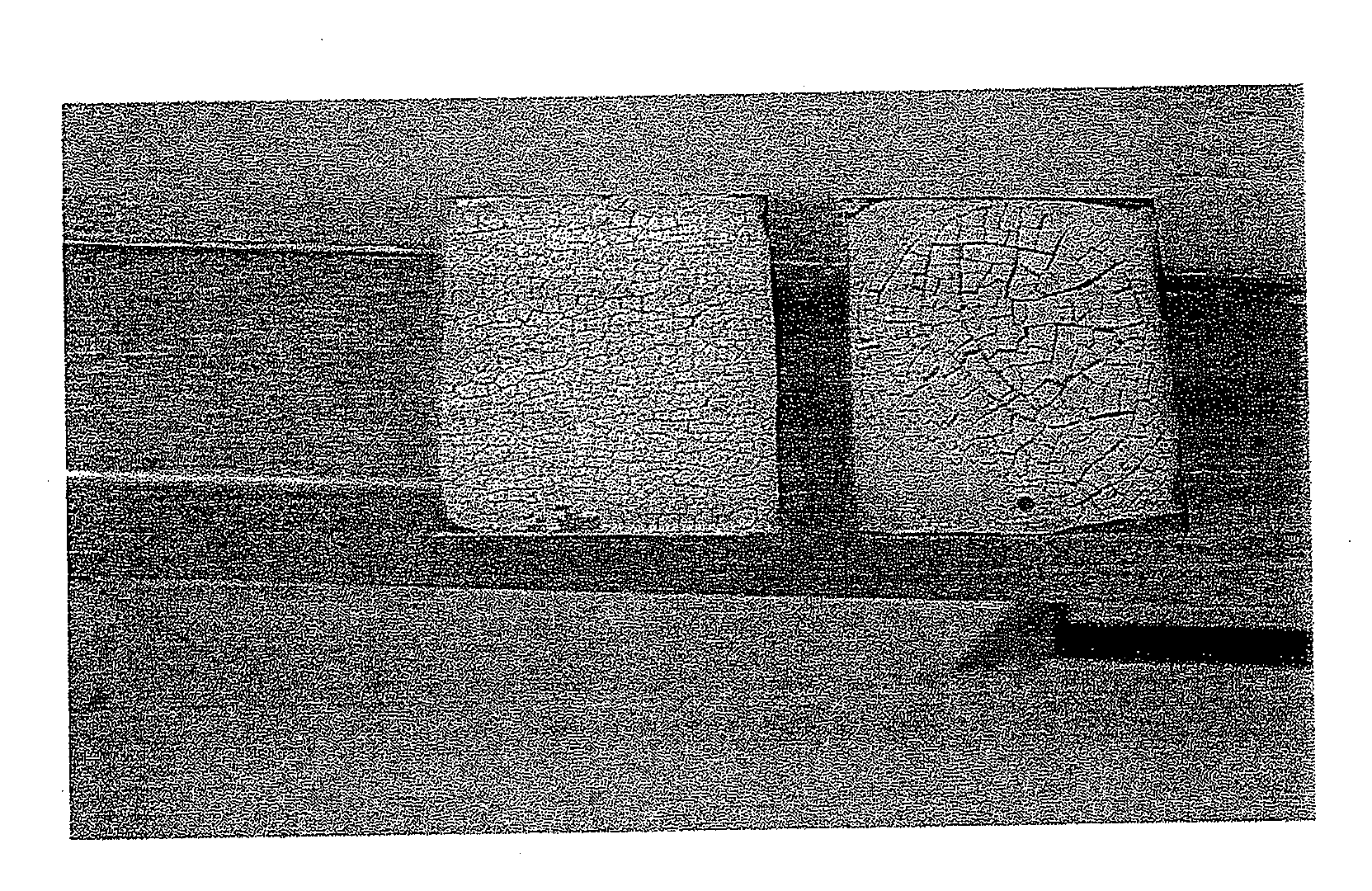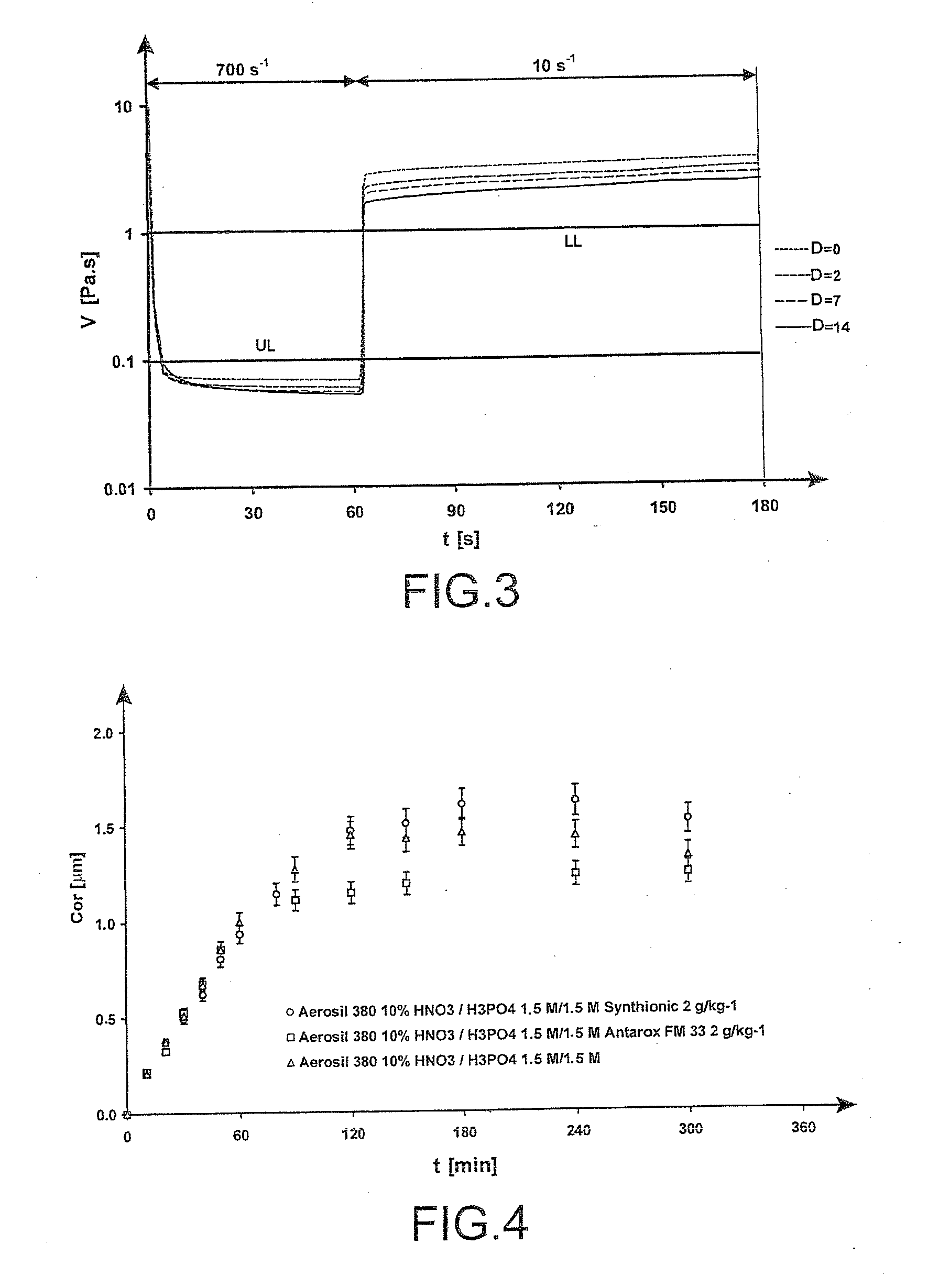Vacuumable Gel for Decontaminating Surfaces and Use Thereof
- Summary
- Abstract
- Description
- Claims
- Application Information
AI Technical Summary
Benefits of technology
Problems solved by technology
Method used
Image
Examples
example 1
[0073]A reference gel was prepared comprising AEROSIL (8 wt %), 0.1M HNO3 and 1.5M H3PO4.
[0074]In this example, the usage conditions of the gel for its drying were the following: 22° C. and 40% relative humidity.
[0075]In order to be able to spray the gel at low pressure, the viscosity limit was set to 100 mPa·s under high shear (700 s−1). In order to attain a gel that did not run down the wall, a viscosity greater than 1 Pa·s under low shear (10 s−1) was necessary.
[0076]This can be expressed graphically by means of the rheogram represented in FIG. 1.
[0077]The viscosity of the gels must preferably be in the blank zones of the graph which guarantee an easy use of the gel.
[0078]The addition of surfactants in a small amount according to the present invention makes it possible to optimize the rheological properties of the vacuumable gels of the prior art.
[0079]FIG. 2 represents the rheograms obtained for various acidic gels containing various surfactants (CRAFOL AP56, SYNTHIONIC P8020 an...
example 2
Effect of the Surfactant on the Drying Time of the Gel
[0091]In this example, the presence of SYNTHIONIC or ANTAROX (trademarks) in an amount of 0.1% was tested in 1.5 M to 3.5 M phosphonitric acid gels comprising 10 wt % of AEROSIL 380 (trademark).
[0092]In the gel, the surfactant molecules were positioned at the gel / air and silica / solution interfaces in order to minimize the contacts with the water molecules. The surface of the gel was therefore covered with surfactant molecules which could slow down the evaporation or accelerate it.
[0093]As regards the effectiveness of the gels, FIG. 4 represents the corrosion kinetics obtained, on aluminium samples treated by the acid gel, the acid gel containing ANTAROX (trademark) at 2 g / kg and the acid gel containing SYNTHIONIC (trademark) at 2 g / kg.
[0094]The operating conditions were the following: 22° C. and 40% relative humidity.
[0095]The experimental results show that the presence of SYNTHIONIC or ANTAROX (trademarks) increases the drying t...
example 3
Effect of the Surfactant on Cracking
[0097]FIG. 5 is a photograph allowing a visual comparison of a gel according to the present invention (on the left) and a gel of the prior art, that is to say without surfactant (on the right) dried under the same temperature, humidity and time conditions.
[0098]An oxidizing gel film containing 0.5M cerium and 3M nitric acid (right-hand reference in the photo) was prepared on a sample made of stainless steel. 1 g / kg of wetting surfactant SYNTHIONIC P8020 was added to the gel composition (left-hand sample).
[0099]The cracking obtained at the surface of the gel containing the surfactant on the left was more homogeneous. The size of the solid residues was monodisperse (1 to 2 mm) (present invention).
[0100]This avoided the formation observed on the right (prior art) of a polydispersity of the size of the larger solid residues (5 to 7 mm) that are more difficult to recover as they are more adherent.
PUM
 Login to View More
Login to View More Abstract
Description
Claims
Application Information
 Login to View More
Login to View More - R&D
- Intellectual Property
- Life Sciences
- Materials
- Tech Scout
- Unparalleled Data Quality
- Higher Quality Content
- 60% Fewer Hallucinations
Browse by: Latest US Patents, China's latest patents, Technical Efficacy Thesaurus, Application Domain, Technology Topic, Popular Technical Reports.
© 2025 PatSnap. All rights reserved.Legal|Privacy policy|Modern Slavery Act Transparency Statement|Sitemap|About US| Contact US: help@patsnap.com



